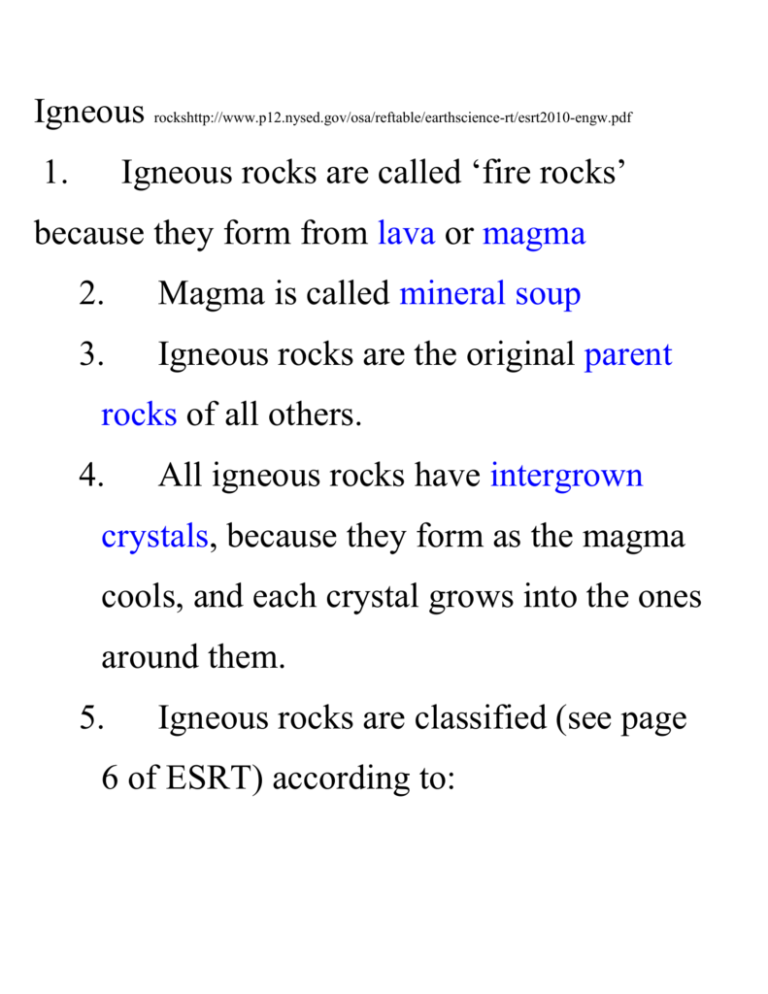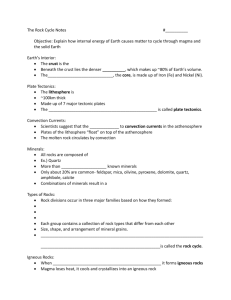Igneous rocks igneous pix
advertisement

Igneous rockshttp://www.p12.nysed.gov/osa/reftable/earthscience-rt/esrt2010-engw.pdf Igneous rocks are called ‘fire rocks’ 1. because they form from lava or magma 2. Magma is called mineral soup 3. Igneous rocks are the original parent rocks of all others. 4. All igneous rocks have intergrown crystals, because they form as the magma cools, and each crystal grows into the ones around them. 5. Igneous rocks are classified (see page 6 of ESRT) according to: a. the mineral composition of the rock, from the magma or lava that forms the rock. As old rock pushes down into the mantle and melts, it mixes with magma that is already there, forming slightly different magma. Over time, different igneous rocks have formed. Minerals have different colors, and these colors help identify the type of igneous rock. b. the textureor grain size of the rock, which is determined by how quickly or slowly the magma cools to form rock. c. Together, mineral composition and texture identify the rock. 6. In the Bowen’s reaction series, the melting points for common igneous minerals are shown 7. magma cooling deep below the ground is called intrusive or plutonic, and the minerals formed will be coarse-grained. b. magma NEAR the surface cools much more quickly, the crystals don’t have much time to form and the rock is called extrusive or volcanic, and the minerals will be fine- grained. c. Glassy minerals form on or above the surface 8. 3 families of igneous rocks: granite, diorite and basaltic are identified according to the type of magma from which they form. a. The GRANITE family, formed from felsic magma, makes up the CONTINENTAL CRUST, which is low density (_2.7g/cm3_) compared with the ocean crust (_3 g/cm3_). b. The basalt family, formed from mafic magma, makes up the ocean crust. Its density explains why the ocean is a basin. c. The third family is the diorite family, both mafic and felsic minerals, 9. Porphyritic textures refer to igneous rocks that have VARIOUS sized minerals, like a chocolate chip cookie. This happens when the magma cools in stages. 10. In summation, Igneous rocks are identified in the lab by comparing their: color, which tells you what minerals are in it, and therefore what magma it came from and the crystal/grain size, which indicates whether the rock cooled quickly or slowly (extrusive or intrusive). Metamorphic Rocks are ‘changed’ rocks 1. They can form from any other rock or rock type. 2. These form when pre-existing rocks are changed due to heat and pressure. (If the old rock melts, then it does not become metamorphic, because melted rock produces magma and igneous rock). 3. Metamorphic rocks are recrystallized/ altered versions of pre-existing rock. a. May line up differently (foliation) b. Develop new crystals 3. 4. Metamorphic Rocks are formed: a. Heat: contact metamorphism magma ‘bakes’ a nearby rock. (at volcanoes, mid-ocean ridges, igneous intrusions) b. Chemically: At mid-ocean ridges when seawater and sediments mix with hot gases c. Pressure: Regional Metamorphism o At subducting boundaries when rock is ground and deformed o When mountains form by tension, compression o Overlying sediments exert so much pressure they change the deep rock 5. Metamorphic rocks are classified according to: a. Texture: if foliation or banding are present, the minerals ‘line up’. For non-foliated rock, there is no alignment. b. Composition of the rock: especially the non-foliated rocks. Classified by the minerals (the acid test identifies marble and hardness shows which is quartzite). 6. Intense pressure from regional metamorphism: minerals align at a right angle to the pressure. This often forms the foliated texture. 7. The type of foliation is described on page ________ of the _____________. 8. Mica in the rock indicates regional metamorphism 9. Rocks changed by intense heat are often called contact metamorphic rocks: they are recrystallized due to the presence of nearby lava or magma flows, which partially melt the rock. 10. Contact metamorphic rocks are found along igneous intrusions where the magma heats the rock.







